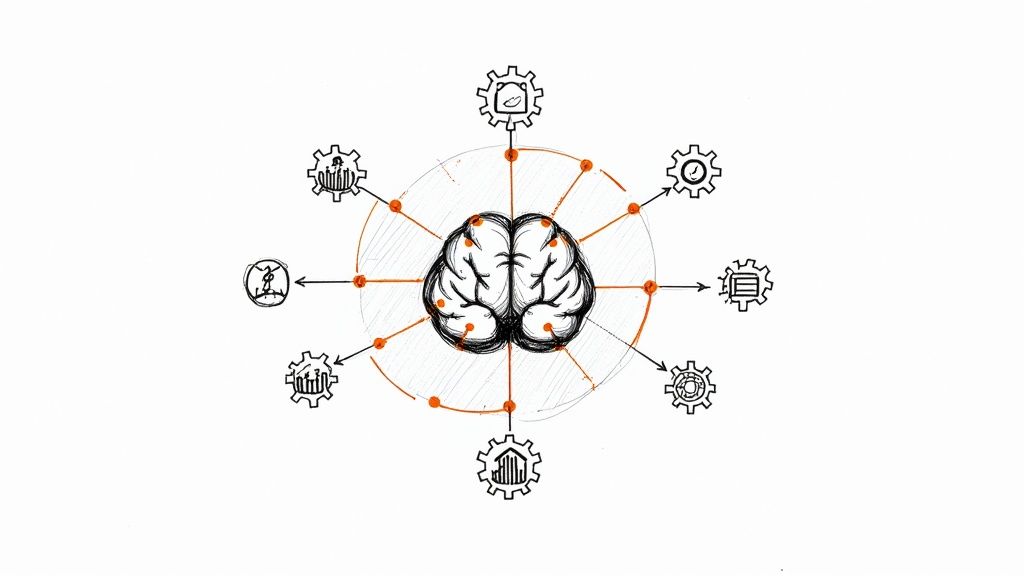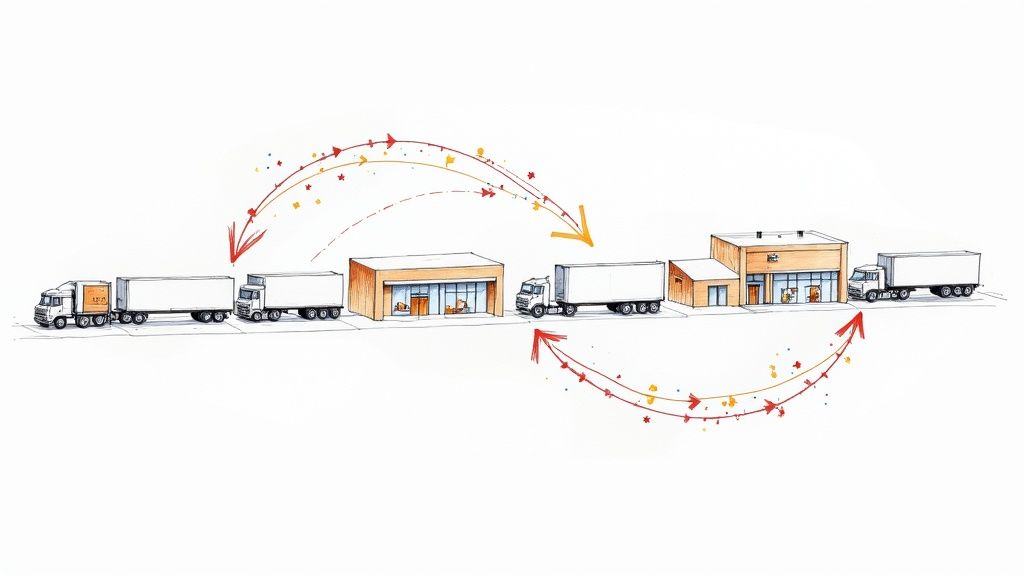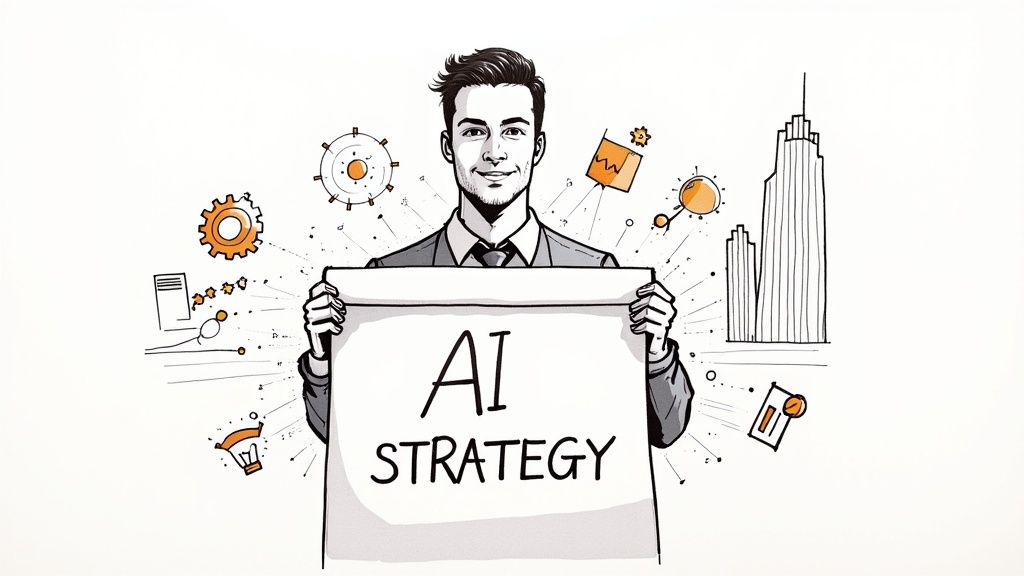8 Practical Applications of AI in Business for 2025
Discover 8 practical applications of AI in business. Learn how AI boosts marketing, sales, & operations with real-world examples and strategic insights.

Artificial intelligence is no longer a futuristic concept; it is a fundamental business tool that drives efficiency, innovation, and growth. Companies across every industry are integrating AI to solve complex problems, automate repetitive tasks, and uncover insights that were previously out of reach. Moving beyond theoretical discussions, this article dives directly into the practical applications of AI in business, offering a clear roadmap for implementation. We will dissect eight high-impact use cases, from intelligent customer service to dynamic pricing and supply chain optimization.
This is not a list of generic success stories. Instead, we provide a deep strategic analysis for each application, breaking down the "how" and "why" behind their success. You will find specific, replicable tactics and actionable takeaways designed to help you build a robust AI strategy framework. Our goal is to demystify AI implementation by examining tangible, real-world use cases and translating them into a strategic advantage for your organization. Whether you are a CEO, CTO, or an operations lead, this guide offers the insights needed to leverage AI effectively, turning powerful technology into measurable business outcomes. For those beginning their journey, our approach to AI co creation ensures your first steps are strategic and impactful.
1. Intelligent Customer Service and Chatbots
One of the most immediate and impactful practical applications of AI in business is the transformation of customer service. AI-powered systems, often seen as chatbots or virtual assistants, leverage natural language processing (NLP) and machine learning to offer instant, 24/7 support. They handle a high volume of routine inquiries, freeing human agents to focus on complex, high-value interactions.
These are not the rigid, script-based bots of the past. Modern AI chatbots understand user intent, recall conversation history, and personalize responses. This enhances the customer experience by providing quick, accurate answers to common questions about orders, returns, or account information.
Strategic Breakdown: Sephora's Messenger Bot
Sephora, a global beauty retailer, implemented a chatbot on Facebook Messenger to provide personalized beauty consultations. Instead of just answering order status questions, the bot engages users with quizzes to understand their preferences and recommends products accordingly.
Key Strategy: Sephora shifted the chatbot's role from a simple Q&A tool to a proactive, value-adding sales and engagement channel. It mimics the in-store consultant experience, driving sales and building brand loyalty directly within a popular social media platform.
Actionable Takeaways for Your Business
- Start with High-Volume Queries: Identify the most common, repetitive questions your support team receives. Automating these first provides the quickest ROI and frees up significant human agent time.
- Focus on Value, Not Just Support: Design your chatbot to do more than just answer questions. Can it help users find products, book appointments, or offer personalized tips? This turns a cost center into a potential revenue generator.
- Plan the Human Handoff: Ensure a seamless transition from the bot to a human agent when a query becomes too complex. A frustrating handoff process can negate all the benefits of the initial AI interaction. A well-defined AI strategy framework is crucial for mapping these user journeys.
2. Predictive Analytics for Sales and Marketing
Another of the most powerful practical applications of AI in business involves leveraging predictive analytics to forecast future outcomes in sales and marketing. AI systems analyze vast datasets, including historical sales figures, customer behavior, and market trends, to identify patterns and predict what will happen next. This empowers teams to move from reactive decision-making to a proactive, data-driven strategy.

These sophisticated models, often powered by tools like the AI Strategy consulting tool, can pinpoint high-value leads, forecast product demand, and optimize marketing spend. For instance, Amazon's legendary recommendation engine, which uses predictive analytics to suggest products you might like, is estimated to drive as much as 35% of its sales.
Strategic Breakdown: Target's Pregnancy Prediction
Years ago, retail giant Target developed a predictive model to identify customers in their second trimester of pregnancy. By analyzing changes in purchasing habits, such as a shift to unscented lotions or specific supplements, the AI could assign a "pregnancy prediction" score. This allowed Target to send highly relevant, timely coupons for baby items before competitors.
Key Strategy: Target used predictive analytics not just to understand past behavior but to forecast a major life event. They transformed transactional data into a powerful, forward-looking marketing tool, enabling hyper-personalized engagement at a crucial moment in the customer journey.
Actionable Takeaways for Your Business
- Prioritize Data Quality: Predictive models are only as good as the data they are trained on. Start by ensuring your customer and sales data is clean, organized, and comprehensive.
- Start Small and Validate: Begin with a focused goal, like predicting customer churn or identifying upsell opportunities. Test your model on a small segment before a full rollout to validate its accuracy and business impact.
- Augment, Don't Replace: Use AI insights as a powerful tool to augment the intuition and expertise of your sales and marketing teams. The combination of machine intelligence and human knowledge is where true competitive advantage lies. A well-defined AI strategy framework can help integrate these predictions into existing workflows.
3. Fraud Detection and Risk Management
Another one of the most critical practical applications of AI in business lies in safeguarding assets through advanced fraud detection and risk management. AI systems analyze thousands of data points per transaction in real-time, identifying subtle, suspicious patterns that are invisible to human analysts. This allows businesses to block fraudulent activities before they cause financial damage.
Unlike static, rule-based systems, AI models learn continuously from new data, adapting to emerging threats from sophisticated fraudsters. By leveraging machine learning, companies can significantly reduce financial losses and protect customer trust while minimizing "false positives" that inconvenience legitimate users. This proactive defense is essential in today's digital economy.
Strategic Breakdown: PayPal's Fraud Prevention Engine
PayPal leverages a complex AI and machine learning engine to analyze every transaction, assessing risk by examining hundreds of variables, from a user's transaction history to their device information and location. This system is designed to distinguish between legitimate and fraudulent behavior with extreme precision, even for first-time users.
Key Strategy: PayPal's AI doesn't just react to known fraud types; it proactively models "what good behavior looks like." By building a deep understanding of normal user patterns, the system can instantly flag anomalies that deviate from this baseline, allowing it to catch new and unforeseen fraud tactics effectively.
Actionable Takeaways for Your Business
- Start with High-Risk Segments: Begin by applying AI fraud detection to your most vulnerable areas, such as high-value transactions or new account openings. This focuses resources where the potential for loss is greatest, delivering a clear and immediate ROI.
- Balance Security with User Experience: Tune your AI models to minimize false declines. An overly aggressive system can alienate legitimate customers. The goal is frictionless security, not a digital fortress that locks everyone out.
- Maintain Human Oversight: Use AI to flag suspicious activity, but retain human experts to review complex or ambiguous cases. This "human-in-the-loop" approach combines the speed of AI with the nuanced judgment of experienced analysts, leading to better accuracy and fewer errors. For organizations looking to implement such systems, a robust approach to AI requirements analysis is the first step.
4. Supply Chain Optimization and Demand Forecasting
Another powerful and one of the most financially impactful practical applications of AI in business involves optimizing the entire supply chain. AI systems analyze vast datasets to predict demand, manage inventory, optimize logistics, and preemptively identify potential disruptions. They move businesses from a reactive to a predictive operational model, driving significant cost savings and efficiency gains.

These sophisticated systems integrate disparate data sources like historical sales, weather patterns, economic indicators, and real-time transit information. By finding hidden patterns in this data, AI can forecast demand with remarkable accuracy, ensuring products are in the right place at the right time. For companies like Walmart and Unilever, this means fewer out-of-stock situations and less capital tied up in excess inventory.
Strategic Breakdown: UPS's ORION System
United Parcel Service (UPS) developed its On-Road Integrated Optimization and Navigation (ORION) system to tackle the immense complexity of its daily delivery routes. The platform uses fleet telematics and advanced algorithms to determine the most efficient path for its 55,000 drivers each day, considering millions of potential route combinations.
Key Strategy: UPS leveraged AI not just for high-level forecasting but for granular, real-time operational decision-making. By optimizing every single driver's route daily, ORION translates complex data into tangible, daily savings in fuel, time, and emissions, compounding to hundreds of millions of dollars annually.
Actionable Takeaways for Your Business
- Begin with a Focused Pilot: Instead of a full-scale overhaul, apply AI forecasting to a specific product line or a single geographic region. This allows you to prove the concept and measure ROI before a wider rollout.
- Prioritize Data Integration: The success of supply chain AI depends on clean, integrated data. Ensure you have systems to connect information from sales, warehousing, suppliers, and logistics partners into a unified view.
- Focus on Demand Sensing: Go beyond traditional forecasting which looks backward. Implement AI tools that sense real-time demand signals from social media trends, local events, and point-of-sale data to create a more agile supply chain. A solid AI strategy framework can help map these complex data inputs to business outcomes.
5. Intelligent Document Processing and Automation
Another highly transformative and practical application of AI in business involves automating how companies handle documents. Intelligent Document Processing (IDP) systems use AI technologies like optical character recognition (OCR) and natural language processing (NLP) to automatically extract, classify, and process information from invoices, contracts, and forms. This eliminates tedious manual data entry, reduces errors, and dramatically speeds up administrative workflows.
Unlike basic OCR, modern IDP understands context and variation in unstructured documents. It can identify key data points like invoice numbers or contract clauses, validate them against existing records, and route the information into ERP or CRM systems, creating a seamless, automated process from document receipt to data integration.
Strategic Breakdown: JP Morgan's COIN
Financial giant JP Morgan deployed a system called COIN (Contract Intelligence) to analyze complex commercial loan agreements. This task, which previously required 360,000 hours of manual work by lawyers and loan officers annually, is now completed by the AI in just a few seconds. The system extracts critical data points and clauses with incredible speed and accuracy.
Key Strategy: JP Morgan targeted a high-volume, high-value, and extremely error-prone process. Instead of a general application, they focused AI on a specific, resource-intensive bottleneck, freeing up highly skilled employees to focus on client advisory and risk assessment rather than document review.
Actionable Takeaways for Your Business
- Target High-Volume, Standardized Documents: Begin your IDP initiative with predictable document types like invoices or purchase orders. This provides a clear path to ROI and helps refine your process before tackling more complex documents.
- Focus on End-to-End Automation: Don't stop at data extraction. Map out the entire workflow from document intake to final approval. Integrating the extracted data directly into your core business systems is where the most significant efficiency gains are realized.
- Implement a Human-in-the-Loop: For critical documents, use AI to do the initial heavy lifting but maintain human oversight. Implement confidence scoring to automatically flag low-certainty extractions for manual review, ensuring accuracy without sacrificing speed. Developing a comprehensive AI strategy framework can help define these critical human-AI interaction points.
6. Personalized Product Recommendations
A cornerstone of modern e-commerce and content platforms, personalized recommendations represent one of the most profitable practical applications of AI in business. These systems analyze vast datasets, including past purchases, browsing behavior, and user preferences, to predict and suggest items that a customer is highly likely to appreciate and buy. This moves beyond simple "customers who bought this also bought" features into a deeply individualized shopping experience.
Using techniques like collaborative filtering and deep learning, AI algorithms identify subtle patterns that are impossible for humans to detect at scale. This not only boosts sales but also significantly enhances customer engagement and retention by making users feel understood. Major players like Amazon attribute over a third of their revenue to this technology, proving its immense commercial power.
Strategic Breakdown: Netflix's Recommendation Engine
Netflix’s success is intrinsically linked to its AI-powered recommendation system, which influences approximately 80% of the content watched on the platform. The algorithm analyzes dozens of signals, from viewing history and ratings to the time of day a user watches, to create a unique homepage for every single subscriber.
Key Strategy: Netflix uses AI not just to recommend existing content but to inform its entire content acquisition and creation strategy. By understanding granular viewing habits, it can green-light original productions with a high degree of confidence, effectively de-risking billion-dollar investments and creating content that resonates with specific audience segments.
Actionable Takeaways for Your Business
- Combine Data Sources: Don’t rely solely on purchase history. Integrate browsing data, cart abandonments, and even mouse movements to build a comprehensive user profile for more accurate recommendations.
- Balance Personalization and Discovery: While showing users what they like is effective, use AI to introduce them to new but relevant items. This "serendipity" prevents filter bubbles and can lead to the discovery of new favorite products, increasing long-term loyalty.
- Implement Real-Time Adaptation: Your recommendation engine should adapt within a single session. If a user starts browsing for a new category of products, the recommendations should shift immediately to reflect this new interest, capturing purchase intent in the moment. Crafting these journeys requires a clear AI strategy framework to be effective.
7. AI-Powered Recruitment and Talent Management
Another one of the most transformative practical applications of AI in business is revolutionizing human resources, specifically in recruitment and talent management. AI-driven systems streamline the entire hiring pipeline, from sourcing candidates and screening resumes to predicting success and even identifying potential bias. They use natural language processing (NLP) to parse thousands of applications in minutes, matching skills and experience against job requirements with incredible accuracy.
These intelligent platforms go beyond simple keyword matching. By analyzing language, experience, and other data points, machine learning algorithms can predict a candidate's potential for success and cultural fit. This allows HR teams to move away from tedious administrative tasks and focus their efforts on engaging the most promising talent, significantly reducing time-to-hire.
Strategic Breakdown: Unilever's Hiring Transformation
Consumer goods giant Unilever faced the immense challenge of processing over 1.8 million job applications annually. By integrating AI, they redesigned their recruitment process, cutting the average hiring time from four months down to just four weeks. The system uses game-based assessments and automated video interviews to screen candidates for initial fit, freeing up recruiters for in-depth, final-stage interviews.
Key Strategy: Unilever used AI not just to accelerate screening but to create a more engaging and objective initial experience. By standardizing the first-round assessment, they reduced unconscious bias and gathered consistent data points on every candidate, improving the quality of their hiring pool.
Actionable Takeaways for Your Business
- Automate the Top of the Funnel: Use AI tools to handle high-volume, repetitive tasks like resume screening and initial candidate communication. This provides immediate efficiency gains and ensures no qualified candidate is overlooked.
- Audit for Fairness and Bias: Regularly review your AI models to ensure they are not inadvertently favoring certain demographics. Train the system on diverse, representative datasets and maintain human oversight in all final hiring decisions.
- Integrate with Performance Metrics: Connect your AI recruitment data to employee performance reviews and key results. This creates a feedback loop that helps refine the predictive accuracy of your hiring models over time, ensuring you are consistently hiring top performers who align with your OKR management tool.
8. Dynamic Pricing and Revenue Optimization
One of the most powerful practical applications of AI in business is the ability to dynamically optimize pricing and revenue in real time. AI-powered pricing engines analyze vast datasets, including competitor pricing, inventory levels, customer demand patterns, and even external factors like weather or local events. Using machine learning, these systems predict optimal price points to maximize profit margins and revenue.
This approach moves beyond static, cost-plus pricing models. Instead, businesses like airlines, e-commerce stores, and ride-sharing services can adjust prices fluidly to match market conditions. For example, Amazon is known to change prices millions of times per day, ensuring competitiveness while maximizing profitability on every transaction.
Strategic Breakdown: Uber's Surge Pricing
Uber's surge pricing is a prime example of AI-driven revenue optimization in action. The algorithm automatically increases fares in areas with high demand and low driver supply. This serves a dual purpose: it incentivizes more drivers to move to that area, increasing supply, and it allocates the limited existing supply to customers willing to pay a premium.
Key Strategy: Uber uses dynamic pricing not just to maximize revenue per ride, but as a core operational tool to manage supply and demand in real time. This ensures platform reliability and driver availability, which are crucial for customer retention and market dominance.
Actionable Takeaways for Your Business
- Set Clear Pricing Boundaries: Define minimum and maximum price points to prevent brand erosion or alienating customers. These rules ensure that even automated pricing aligns with your overall brand strategy and perceived value.
- Start with Low-Risk Segments: Test dynamic pricing on specific products, customer segments, or during off-peak periods. This allows you to gather data and refine your algorithms without risking your core revenue streams.
- Monitor and Integrate Data: A successful strategy relies on real-time data. Integrating your pricing engine with a comprehensive financial insights dashboard allows you to track the impact on revenue and profitability, ensuring your pricing decisions are always data-backed and strategically sound.
Practical AI Business Applications Comparison
AI Application Implementation Complexity Resource Requirements Expected Outcomes Ideal Use Cases Key Advantages
Intelligent Customer Service and Chatbots
Low to Medium; 2-12 weeks
Moderate setup and ongoing maintenance
24/7 support, faster response, reduced costs
Customer support, multi-channel engagement
Scalable, cost-effective, multilingual, personalized
Predictive Analytics for Sales and Marketing
Medium to High; requires technical expertise
Large, high-quality historical data
5-10% revenue increase, improved targeting
Sales forecasting, marketing optimization
Data-driven decisions, better conversions, budget efficiency
Fraud Detection and Risk Management
High; complex integration and compliance
Extensive historical data, ongoing tuning
50-90% fraud loss reduction, real-time detection
Financial transactions, security systems
High accuracy, scalability, compliance support
Supply Chain Optimization and Demand Forecasting
High; 6-18 months for enterprise deployment
Significant integration and training effort
15-25% cost reduction, improved forecast accuracy
Inventory, logistics, supplier management
Cost savings, risk mitigation, operational efficiency
Intelligent Document Processing and Automation
Medium; initial training with large sample sets
OCR tools, integration with workflows
80-95% faster processing, error reduction
Document-heavy workflows, compliance
High accuracy, 24/7 operation, error elimination
Personalized Product Recommendations
Medium; requires substantial data and tuning
Customer behavior data, real-time analytics
2-5% revenue increase, higher engagement
E-commerce, content platforms
Improved conversion, customer insights, cross-selling
AI-Powered Recruitment and Talent Management
Medium to High; ongoing audits and monitoring
Diverse training data, human oversight
30-50% cost reduction, 20-30% quality improvement
Hiring, talent screening
Faster hiring, bias reduction, predictive quality
Dynamic Pricing and Revenue Optimization
High; complex coordination and data integration
Real-time data, cross-functional inputs
2-8% revenue increase, optimized margins
Retail, travel, services pricing
Real-time price adjustment, revenue growth, competitive edge
From Strategy to Impact: Your Next Steps in AI
We've explored a wide spectrum of practical applications of AI in business, moving beyond theoretical hype to examine concrete, value-driven implementations. From deploying intelligent chatbots that redefine customer service to leveraging predictive analytics for laser-focused marketing campaigns, the message is clear: AI is no longer a future concept but a present-day competitive advantage. The examples, from dynamic pricing in e-commerce to AI-powered talent management in HR, demonstrate that a well-defined strategy can transform core business functions, driving efficiency, profitability, and innovation.
The common thread linking these successful implementations isn't just technology; it's a strategic mindset. These organizations didn't just adopt AI, they integrated it. They identified specific pain points, aligned AI capabilities with business objectives, and committed to a data-driven culture, as we explored in our AI adoption guide. This transition from a reactive to a predictive operational model is the most significant takeaway for any leader looking to harness AI's power.
Your Actionable Path Forward
Moving from inspiration to implementation requires a structured approach. The journey begins not with code, but with clarity. Here are the essential next steps to translate these insights into tangible results for your organization:
- Audit and Identify Opportunities: Begin by mapping your current processes. Where are the bottlenecks? Which tasks are repetitive and time-consuming? Use this internal audit to pinpoint the highest-impact areas for AI intervention, whether in supply chain optimization or intelligent document processing.
- Define a Clear Business Case: For each potential application, build a solid business case. What specific problem will it solve? What is the expected ROI? A clear objective is crucial for securing buy-in and measuring success. Our guide on AI use case selection provides a framework for this critical step.
- Develop a Phased Rollout Plan: Avoid a "big bang" implementation. Start with a focused pilot project to test, learn, and demonstrate value quickly. This iterative approach, a core component of a robust AI strategy framework, minimizes risk and builds momentum for broader adoption. A thorough AI requirements analysis is the first step in this process.
- Foster an AI-Ready Culture: Technology is only half the equation. Success depends on your team. Invest in upskilling, promote cross-departmental collaboration, and communicate the "why" behind your AI initiatives to foster enthusiasm and support.
The true value of these practical applications of AI in business lies not in their novelty, but in their replicability. By focusing on strategic alignment and taking deliberate, measured steps, you can navigate the complexities of integration and unlock transformative growth. The key is to start now, build a solid foundation through expert AI strategy consulting, and scale intelligently.
Ready to move from theory to action? Ekipa AI specializes in AI co creation, partnering with you to develop and implement a custom AI strategy that delivers measurable business impact. Connect with our expert team today to translate your strategic vision into a powerful reality.



